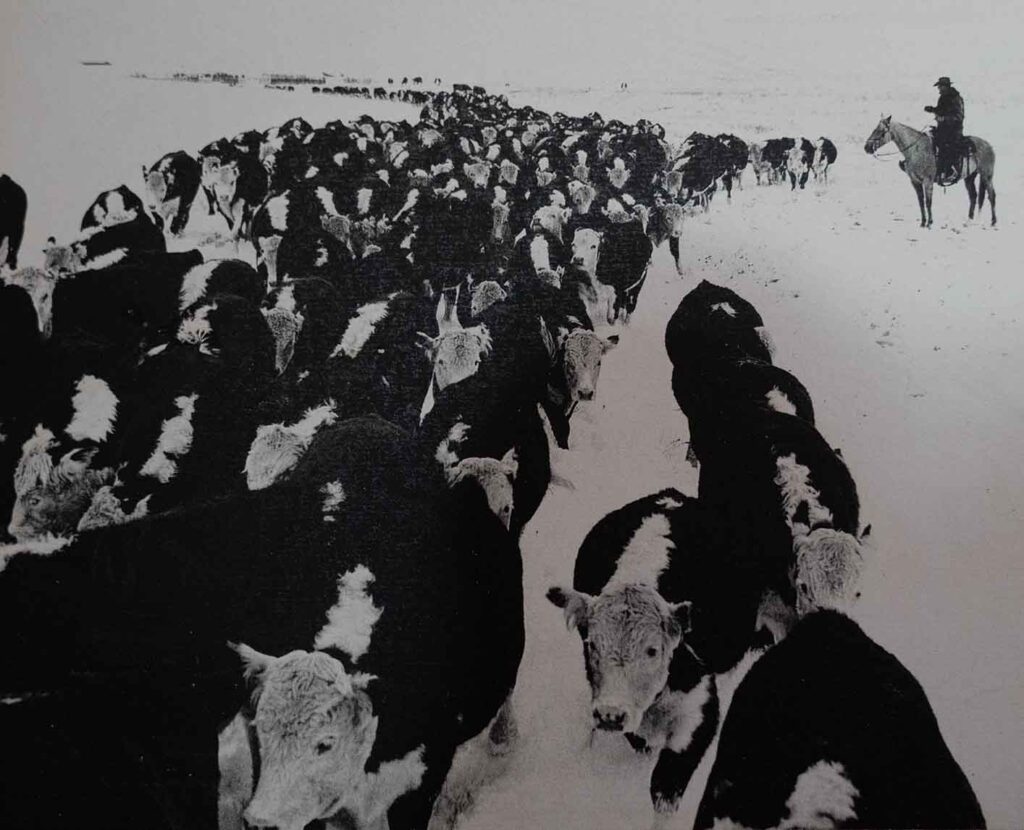
In the year 1918 we sold 27 sections of ground comprising a strip nine by three miles from the north end of our ranch and which was fine fertile land, to three Hutterite colonies who had come in from South Dakota seeking land in this country because they had been unable to obtain military exemption in the United States. This land had become too high in price to justify retaining it as a cow range, although some of it had been broken up and farmed under a renter’s system for some seven or eight years. After selling this land our cattle operations had to be reduced and so we sold about 3,000 head of cattle to Ray Knight and his partner Jim Watson in the summer of the year 1919. 1918 and 1919 had both been extremely dry years with very little rain, and very little snow in the winter. We sold these cattle at high prices and then thought that we were fairly safe in going through the coming winter with some 2,400 head of cattle which we wanted to retain as a breeding herd.
The winter of 1919-20 began in October and continued until the middle of May, 1920. Lots of snow fell and everyone was short of feed. We had contracted for 600 tons of baled hay in the Coaldale district at $30.00 per ton and had also contracted the hauling of this hay from Magrath to the ranch at $3.00 per ton. Owing to the bad roads and to the tremendous demand for hay, all of our hay was not delivered to us and our needs kept getting more urgent. By the time the end of winter came, we were paying $60.00 per ton for hay shipped in from Quebec and were paying $20.00 per ton to haul it from Magrath to the ranch. We used anything we could get for feed and paid any price that was asked for it. We were able to carry our cattle through with scarcely any loss, but had paid more than their worth in the cost of the feed which we purchased for their maintenance. Other ranchers had spent a lot of money for feed and had then lost a big part of their cattle. Some shipped cattle down to Texas and Nebraska for wintering and also others to the State of Washington. By the summer of 1920, the cattle market had collapsed, and so many ranchers found themselves broke because of the high cost of wintering and the collapse of the cattle market.
Cattle prices picked up again gradually after 1921 so that when the year 1928 came along, we were able to sell weaned calves for $45 a head and cows and steers were again bringing a good price. However, about the time 1932 had arrived, we sold fat two-year-old heifers to the packers at 2 1/2c per lb. And guaranteed a 54% dressing; cows were down to 1 1/2c per lb. for the best ones, 1/2c for common ones. Good, fat, big steers brought around 3 1/4c and packers really considered it a favor to take our cattle off our hands. Also, the years 1932, 1933 and 1934 had not been years of plentiful precipitation, and consequently feed was not plentiful and neither were the winters any too easy.
The U. S. Smoot-Hawley Tariff Act had been passed by the United States Senate calling for 3c per lb. live weight tariff on Canadian cattle shipped into the United States. Cattle and hogs were being slaughtered in the United States merely to get rid of them under government direction and compensation. Canadian producers, shut out of the United States market, were desperate and were willing to try anything that promised to relieve their sorry plight. Shipments of live cattle were made to England and Scotland both for killers and feeders. Boat space was scarce and was tied up by speculators. We made one shipment of yearling steers to Scotland, and after getting the big settlement sheets in terms of pounds, shillings and pence all figured out in terms of dollars, found that we would have been as well off by accepting the ruinous prevailing prices at home. The normal British market for cattle has not been any good to us for many years, and it is my thought that it never will be.
(To Be Continued)
